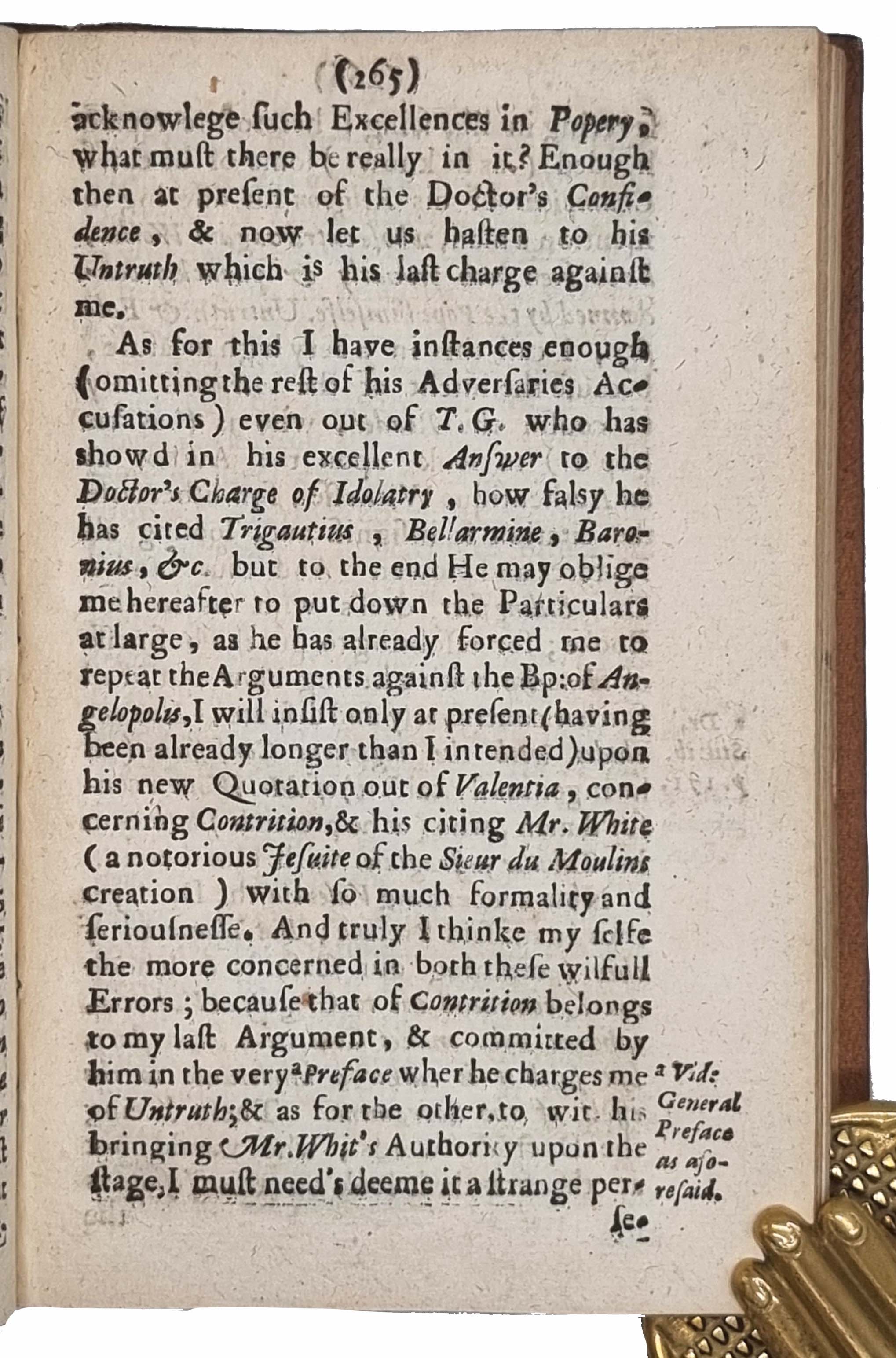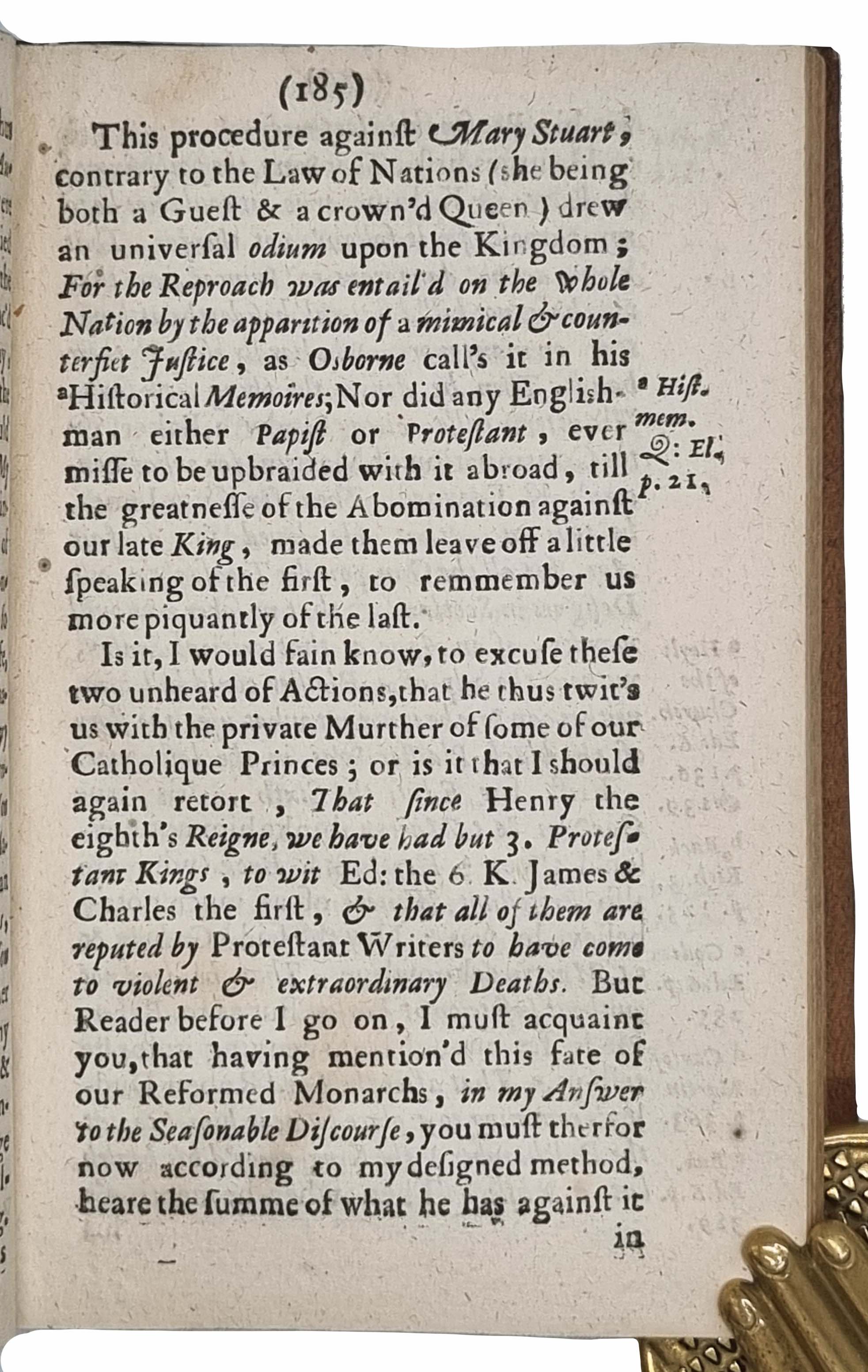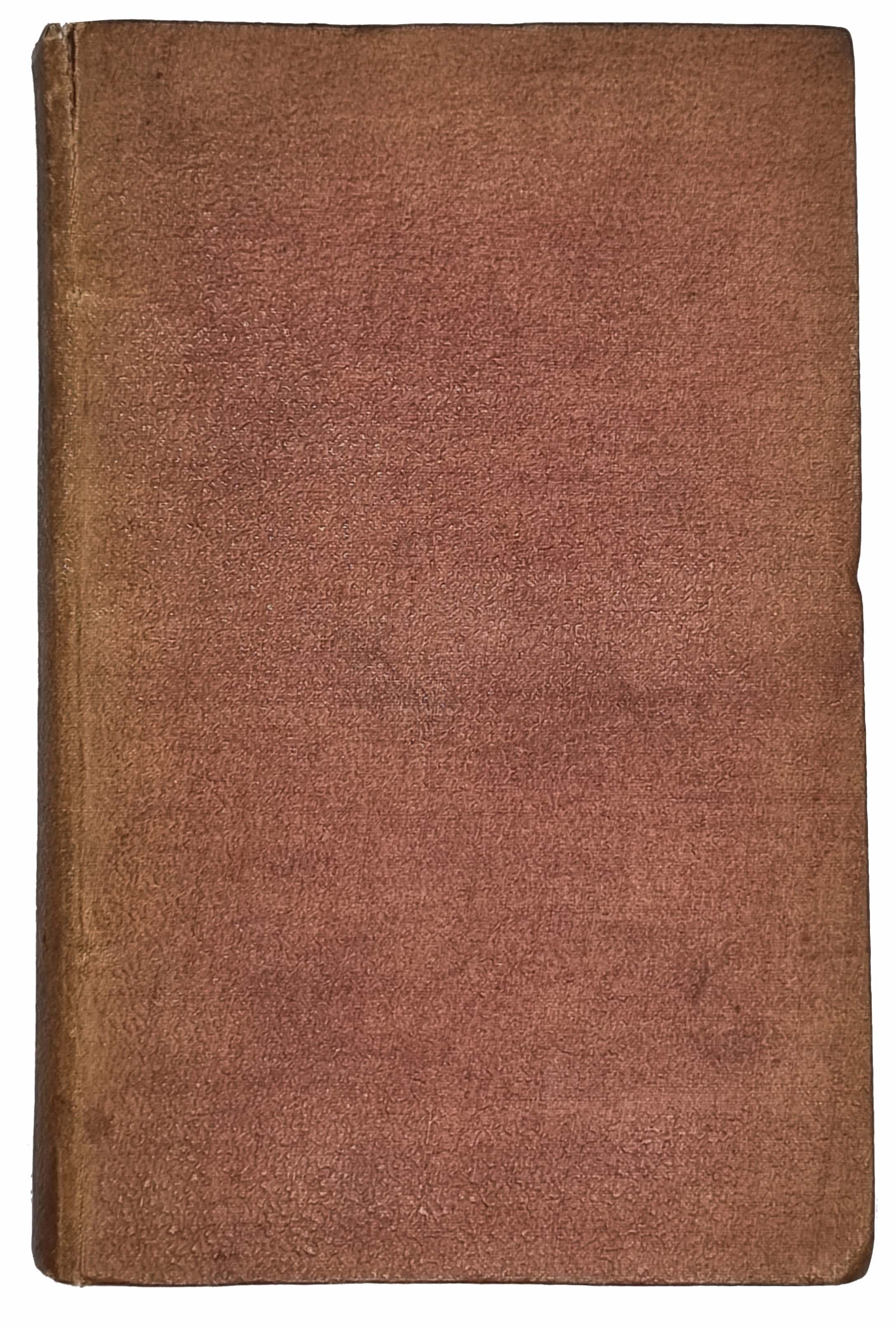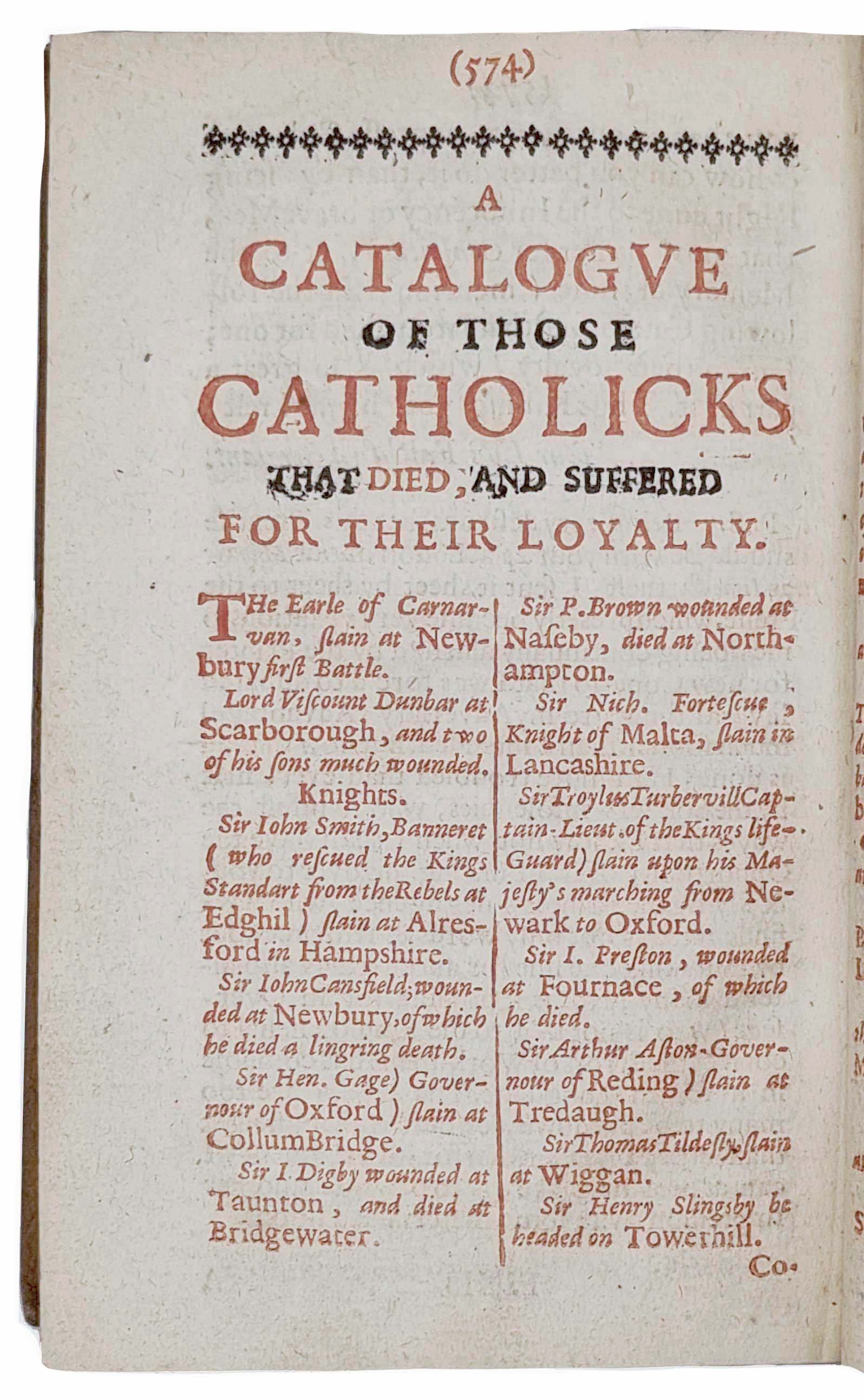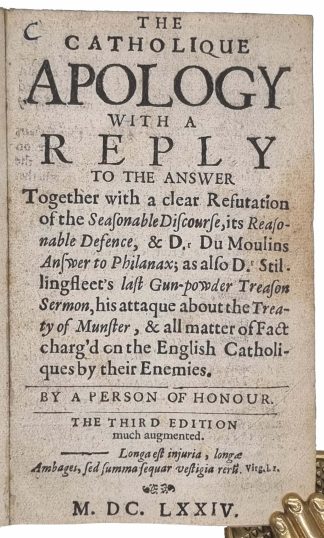CASTLEMAINE, Roger Palmer, Earl of
The Catholique apology … & D.r Du Moulins Answer to Philanax; as also D.r Stillingfleet’s last gun-powder treason sermon, his attaque about the treaty of Munster, & all matter of fact charg’d on the English Catholiques by their enemies.
[Antwerp], s.n., M. DC. LXXIV. 1674£2,250.00
FIRST EDITION thus. 8vo. pp. [viii], 600. a , A-2O , 2P . With slip cancel on last line of p. 597. “A catalogue of those Catholicks that died and suffered for their loyalty” (p. 574-580) printed in red. Roman and Italic letter. Floriated woodcut initials and headpieces, typographical ornaments, bookplate of Milltown Park library on pastedown, with the ex-legato label of William O’Brian below. Light age yellowing, cut a little close in places, the odd spot or mark. A good copy in late C19th percaline.
A largely expanded edition of “A reply to the answer of the Catholique apology, originally published in 1668; the work is a reply to “The late apology in behalf of the papists,” “A seasonable discourse shewing the necessity of maintaining the established religion, in opposition to popery” and “A reasonable defence of the Seasonable discourse”, all by William Lloyd. It also contains a reply to “A vindication of the sincerity of the Protestant religion in the point of obedience to sovereigns” by Peter Du Moulin and “A sermon preached November V. 1673. at St. Margarets Westminst.” by Edward Stillingfleet. Roger Palmer “in the course of a turbulent career, during which he was imprisoned in the Tower of London at least five times, .. tenaciously continued to speak out on behalf of English Catholics and to argue for religious toleration. When not engaged in polemics, he had time to invent a new type of globe, whose description, amply illustrated, was published in 1679 by Joseph Moxon, the royal hydrographer. …Castlemaine’s authorial career began in 1666 with a short treatise which later became known as “The Catholique Apology.” In its original form, it appeared anonymously under the long title “To all the Royalists that suffered for his Majesty, and to the rest of the good people of England. The humble apology of the English Catholicks.” This was an appeal for recognition of Catholic loyalty during the Civil War. It finishes with a “Bloudy Catalogue,” flamboyantly printed in red ink, of those Catholics who died in the war. Somewhat intemperate and theatrical, the pamphlet earned for Castlemaine the epithet “the Apologist.” It was answered, rebutted, and refuted several times, until in its last edition of 1674 the whole set of interchanges had swollen enormously in size from a mere 14 to 608 pages. Lord Castlemaine continued his pro-Catholic writings with The Compendium (of the Popish Plot trials, 1679) and The Earl of Castlemain’s Manifesto (1681).” Charlotte E. Erwin. “Bookish Plots.”
“The Earl of Castlemaine, one of the chief spokesmen for Catholics from 1666 to 1688, heartily agreed that persecution was counterproductive. In France, he observed, the Huguenots had never had fewer converts than when they were secure under the laws. Expressing his horror of England’s 24 penal laws for religion, he declared: ‘I abominate for my own part the very thought of blood and persecution upon a religious account’. He had good reason: under the 1585 statute, for one, a Catholic priest could be hanged and quartered as a traitor only for being a priest in England, nothing more. In the summer of 1679, eight priests were executed under this statute, one of them ninety years of age. Castlemaine urged two grounds for granting freedom of worship to religious minorities: large numbers and long continuance. First, it had been recognised by the Edict of Nantes in 1598 that when a religion had grown large in numbers, only prayers, preaching, and books might be used against it, not legal coercion. This ground would have justified giving English Puritans at least the freedom to meet in conventicles. Second, it had been recognized since the days of Constantine and Ethelbert that those following an ancient form of worship, one of long, uninterrupted continuance in the land, had a right to be tolerated by those setting up a new religion. This ground would have justified giving Catholics at least the freedom to worship privately. Ironically, although they were only one per cent of the population, Catholics of that time were denied a privilege that even the Ottoman Turks granted their co-religionists in Eastern Europe, namely, the liberty to worship in the privacy of their homes. Besides that, they were under legal penalties in England for not participating in the state-appointed worship.” Anne Barbeau Gardiner ‘Catholic Authors and Liberty of Conscience: 1649-1771’
The work includes a most interesting bibliography as it contains “A catalogue of all the authors mentioned in this treatise, with the year when, and the place where they were printed” giving a very interesting snap shot of the controversial works available to the author. Also of great interest is the “catalogue of those Catholicks that died and suffered for their loyalty” in England, printed in red at the end of the volume, which continues with a list of the “Names of such Catholiks, whose Estates (both real and Personal) were sold, in pursuance of an act made by the Rump, July 16, 1651, for their pretended Delinquency.”
In stock



